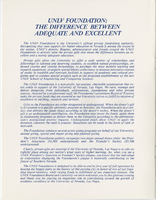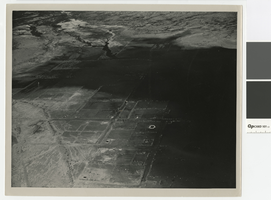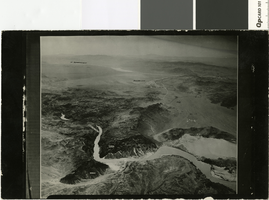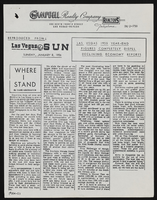Search the Special Collections and Archives Portal
Search Results
Jesma and Carlyle Wilcox oral history interview
Identifier
Abstract
Oral history interview with Jesma and Carlyle Wilcox conducted by Sally Griffis on February 19, 1976 for the Ralph Roske Oral History Project on Early Las Vegas. Jesma Wilcox begins by describing her family ranch, how her father leased the property to tenants, and what it was like living without air conditioning and refrigeration. She describes using a nearby stream as a water source, recreational activities, and the Mormon settlers and missionaries who first settled on the ranch. Wilcox talks about her religious involvement with the Mormon Church and life in Las Vegas, Nevada during the mid-twentieth century, as well as how Las Vegas has changed. Wilcox, with her husband Carlyle, also discusses the history of the nuclear weapons tests. Carlyle then describes the construction of the Basic Magnesium Plant in Henderson, Nevada.
Archival Collection

Glass slides of Las Vegas hotels and aerial views of Clark County (Nev.), 1950s-1960s (tray 1 of 3)
Date
Archival Collection
Description
Slides collected by the Culinary Workers Union Local 226 depict Las Vegas and Clark County during the 1950s and the 1960s. Individual photographs show the Strip, downtown Las Vegas, Boulder City, Lake Mead, the Hoover Dam, and individual hotels (including the Flamingo, Tropicana, El Rancho, Dunes, Sahara, Desert Inn, Stardust, Landmark, Thunderbird, Sands, Tallyho, Riviera, Golden Nugget, Mint, Binion's Horsehoe, Pioneer Club, Fremont, and Four Queens). Aerial shots and photographs of buildings under construction, marquees, and interiors are included. There are also photos of showgirls and the Las Vegas Convention Center. Tray 1 of 3. The original slides were retained by the Union.Arrangement note: Series V. Glass slides
Image
Elizabeth Harrington Collection of Essays
Identifier
Abstract
This collection contains the original drafts of the thirteen essays that Elizabeth Harrington wrote about her life in early Las Vegas, Nevada. These articles were written from her memory and experiences of life in Las Vegas beginning in the early 1900s, and were published in the Nevadan section of the Las Vegas Review-Journal from 1975-1979.
Archival Collection

Program from Christmas with Class at the Thomas and Mack Center, December 16, 1983
Date
Description
This program is from the gala opening of the Thomas and Mack Center at the University of Nevada Las Vegas in 1983, which featured a celebrity lineup including Frank Sinatra, Dean Martin and Diana Ross. The program provides details of the contributions of Jerome Mack and Parry Thomas to the University of Nevada, Las Vegas.
Text

Transcript of interview with Chet Carrigan by Robert Kahre, February 17, 1981
Date
Archival Collection
Description
Text

Transcript of interview with Helen M. Clark by Danny Winegar, March 5, 1979
Date
Archival Collection
Description
Text

Aerial photograph of Saint Thomas, Nevada, being covered by Lake Mead, June 1938
Date
Archival Collection
Description
Aerial view of St. Thomas, Nevada, being covered by Lake Mead. Stamped on back of photo: Photograph by Bureau of Reclamation, Boulder Canyon Project, Boulder City, Nevada
Image

Aerial photograph of Black Canyon, Colorado River and Boulder City location before dam construction, 1920s
Date
Archival Collection
Description
Aerial view of Black Canyon, Colorado River, and Boulder City location before dam construction showing elevation.
Image

